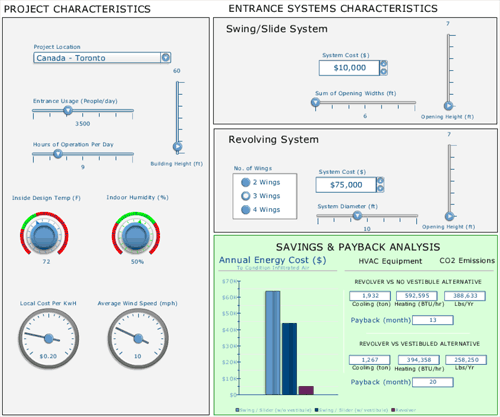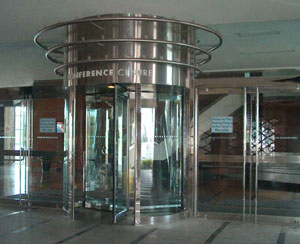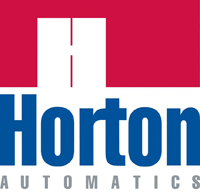Revolving Doors: A Greener, More Secure Environment
Do Revolving Doors Really Save Money?
The answer to this question is a definitive YES. Empirical studies conducted by the Massachusetts Institute of Technology and ASHRAE have demonstrated that revolving doors are indeed a significant source of energy savings and hence a contributor toward a LEED sustainable design. The study concluded that the amount of energy to cool or warm a building is directly related to the amount of air exchanged to or from the building. Since revolving doors yield a better airlock than traditional swing or sliding doors, it follows that the energy required to keep the building at a preset temperature is lower than using a traditional entrance. Naturally, there are several factors involved in determining the saving, namely:
- Location of the entrance. Weather conditions are a key factor
- Number of hours the entrance is in operation (traffic)
- Desired temperature inside the facility
- Humidity and wind speed
- Building height
- Cost per kWH
Let’s take for example a building in the city of Toronto. The facility is 60 feet tall using a 3-wing 120 inch diameter revolving door instead of a vestibule entrance with two 168 inch sliding doors (72 inch net slide opening) results in the following savings:
(follow other assumption in simulation below):
- Cooling equipment savings of 1,267 tons
- Heating savings of 394,358 BTU/hr
- Reduced CO2 emissions of 258,250 lbs./yr.
- A payback using a revolving door of 20 months
| Energy Savings Simulation Results Hypothetical 60 Foot Tall Building in Toronto |
 |
 Combine Function with Aesthetics
Combine Function with Aesthetics
Now that it is clear what a revolving door can do for your entrance, it’s important to review another equally important aspect. Will this door give the intended look of my entrance and will it meet an architect’s aesthetic needs? Major airports, hotels, hospitals, and casinos have all chosen a revolving door for the enhanced grand appearance. While enjoying the energy efficient benefits previously discussed, revolving doors meet high architectural aesthetics and appeal. The material finish can be matched to adjacent construction and the wing/drum design can match important sight lines. Although revolving doors have been around for over 100 years, it’s the next 10 years that will see major increase in demand and acceptance as a preferred entrance solution.
Photos and images courtesy Horton Automatics
 |
Horton Automatics is a leading manufacturer of automatic entrance systems including sliding, swinging and revolving doors as well as platform screen doors, industrial doors and service windows. Horton is headquartered in Corpus Christi, Texas. Horton Automatics |








